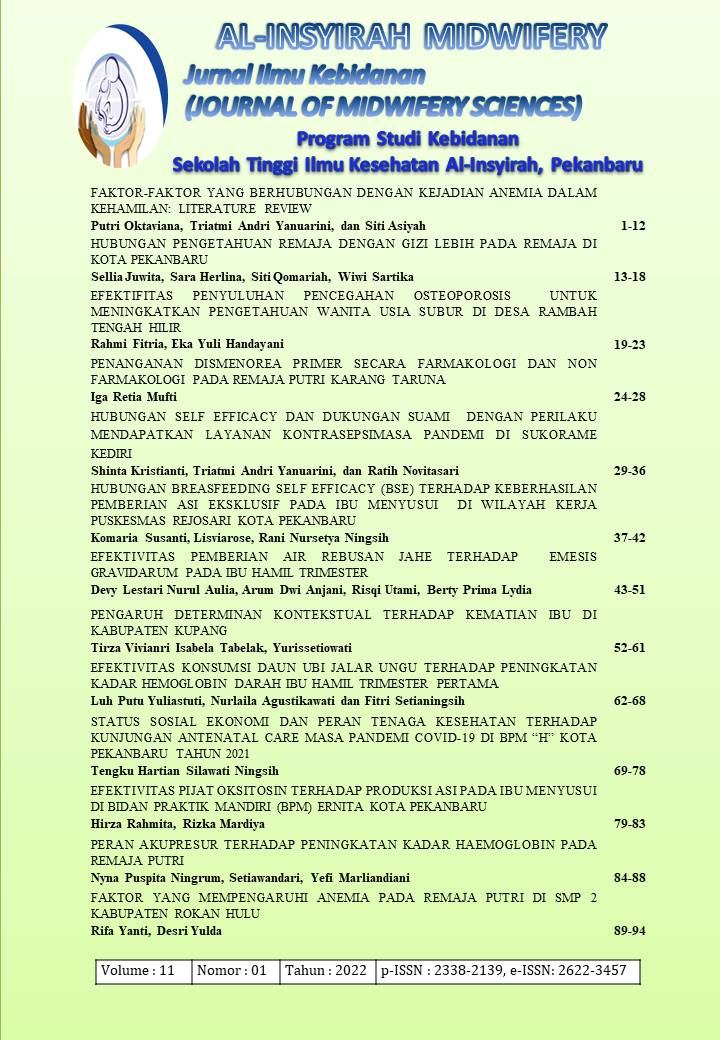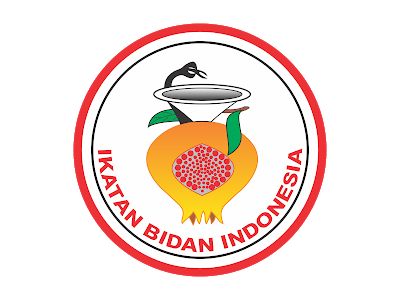EFEKTIVITAS PIJAT OKSITOSIN TERHADAP PRODUKSI ASI PADA IBU MENYUSUI DI BIDAN PRAKTIK MANDIRI (BPM) ERNITA KOTA PEKANBARU
DOI:
https://doi.org/10.35328/kebidanan.v11i1.2141Keywords:
Pijat Oksitosin, Produksi ASIAbstract
One of the reasons mothers do not breastfeed is a lack of confidence in her breastmilk production. Oxytocin hormone is an important trigger of prolactin secretion, which plays a role in the milk ejection process/milk ejection reflex. One of the non-pharmacological therapies to activate the oxytocin hormone is back massage or oxytocin massage for nursing mothers. The purpose of this study was to determine the effectiveness of oxytocin massage on milk production in nursing mothers. This type of research is quantitative with a quasi experimental research design. The research was conducted in BPM Ernita, Pekanbaru city. The population in this study were all mothers giving birth in BPM Ernita last 3 months a total of 30 breastfeeding mothers. Sample size of this study was 15 respondents who were given oxytocin massage treatment and 15 respondents as the control group. Data analysis was performed by univariate and bivariate computerization using the Mann Whitney test. The results of this study there was an effectiveness of oxytocin massage. on milk production in breastfeeding mothers at BPM Ernita, Pekanbaru city (p = 0.000). It is hoped that health workers, especially midwives, can apply oxytocin massage and provide additional information about oxytocin massage to increase breast milk production for breastfeeding mothers and their families.
Downloads
References
Christian, L. M. (2012). Psychoneuroimmunology in pregnancy: Immune pathways linking stress with maternal health, adverse birth outcomes, and fetal development. Neuroscience and Biobehavioral Reviews, 36(1), 350–361. https://doi.org/10.1016/j.neubiorev.2011.07.005
Dinas Kesehatan Provinsi Riau. (2018). Profil Kesehatan Provinsi Riau.
Farida, S., Sulistyorini, E., Bella, R., & Pangestu, R. (2021). Oxytocin massage increase milk production during breastfeeding. International Conference of Health, SCience and Technology, 1(1), 80–82.
Haryono, R. (2014). Manfaat ASI Eksklusif untuk Buah Hati Anda. Yogyakarta: Gosyen Publishing.
Kemenkes RI. (2017). Profil Kesehatan Indonesia 2016. Jakarta.
Oot, L., Sommerfelt, A. E., Sethuraman, K., & Ross, J. (2015). Food and Nutrition Technical Assistance III Project Estimating the Effect of Suboptimal Breastfeeding Practices on Child Mortality : A Model in PROFILES for Country-Level Advocacy.
Sari, L. P., Salimo, H., & Budihastuti, U. R. (2017). Optimizing the Combination of Oxytocin Massage and Hypnobreastfeeding for Breast Milk Production among Post-Partum Mothers. Journal of Maternal and Child Health, 02(01), 20–29. https://doi.org/10.26911/thejmch.2017.02.01.03
Utami Budi, R., Astutik, P., Rukmawati, S., Nurhayati, R., & Retnoningrum, A. D. (2020). Effectiveness of oxytocin massage and breast treatment about the adequacy of breast milk in post partum. European Journal of Molecular and Clinical Medicine, 7(2), 4725–4732.
WHO. (2009). Infant and young child feeding. Model Chapter for textbooks for medical students and allied health professional.
Winberg, J. (2013). Oxytocin and Prolactin Levels in Breast‐Feeding Women. Correlation with milk Yield and Duration of Breast‐feeding. Acta Obstetricia et Gynecologica Scandinavica, 69(4), 301–306. https://doi.org/10.3109/00016349009036151
World Health Organization. (2016). BREASTFEEDING COUNSELLING A TRAINING COURSE PARTICIPANTS ’ MANUAL PART ONE Sessions 1-9. Training Manual, 1–171. Retrieved from https://www.who.int/maternal_child_adolescent/documents/pdfs/bc_participants_manual.pdf
Downloads
Published
Issue
Section
License
Copyright (c) 2022 Al-Insyirah Midwifery: Jurnal Ilmu Kebidanan (Journal of Midwifery Sciences)

This work is licensed under a Creative Commons Attribution 4.0 International License.














